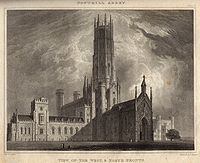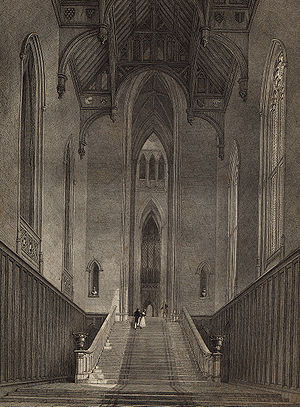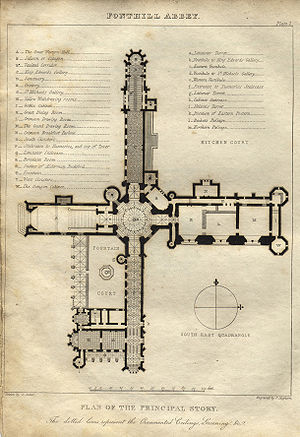
Fonthill Abbey
Encyclopedia



Fonthill Gifford
Fonthill Gifford is a village in Wiltshire, England. Its population has dwindled from 493 in the 1801 Census to 120 in the 2001 Census.The current Church of England parish church of All Saints was built in 1864–66 to designs by the Gothic Revival architect T.H. Wyatt...
in Wiltshire
Wiltshire
Wiltshire is a ceremonial county in South West England. It is landlocked and borders the counties of Dorset, Somerset, Hampshire, Gloucestershire, Oxfordshire and Berkshire. It contains the unitary authority of Swindon and covers...
, England
England
England is a country that is part of the United Kingdom. It shares land borders with Scotland to the north and Wales to the west; the Irish Sea is to the north west, the Celtic Sea to the south west, with the North Sea to the east and the English Channel to the south separating it from continental...
, at the direction of William Thomas Beckford
William Thomas Beckford
William Thomas Beckford , usually known as William Beckford, was an English novelist, a profligate and consummately knowledgeable art collector and patron of works of decorative art, a critic, travel writer and sometime politician, reputed to be the richest commoner in England...
and architect James Wyatt
James Wyatt
James Wyatt RA , was an English architect, a rival of Robert Adam in the neoclassical style, who far outdid Adam in his work in the neo-Gothic style.-Early classical career:...
. It was constructed near the site of the Palladian
Palladian architecture
Palladian architecture is a European style of architecture derived from the designs of the Venetian architect Andrea Palladio . The term "Palladian" normally refers to buildings in a style inspired by Palladio's own work; that which is recognised as Palladian architecture today is an evolution of...
house, later known as Fonthill Splendens, which was constructed by his father, William Beckford
William Beckford (politician)
William Beckford was a well-known political figure in 18th century London, who twice held the office of Lord Mayor of London . His vast wealth came largely from his plantations in Jamaica...
, to replace the Elizabethan
Elizabethan architecture
Elizabethan architecture is the term given to early Renaissance architecture in England, during the reign of Queen Elizabeth I. Historically, the period corresponds to the Cinquecento in Italy, the Early Renaissance in France, and the Plateresque style in Spain...
house that Beckford père had purchased in 1744 and which had been destroyed by fire in 1755. The abbey is now almost all demolished
Demolition
Demolition is the tearing-down of buildings and other structures, the opposite of construction. Demolition contrasts with deconstruction, which involves taking a building apart while carefully preserving valuable elements for re-use....
.
History
Fonthill Abbey was a brainchild of William Thomas BeckfordWilliam Thomas Beckford
William Thomas Beckford , usually known as William Beckford, was an English novelist, a profligate and consummately knowledgeable art collector and patron of works of decorative art, a critic, travel writer and sometime politician, reputed to be the richest commoner in England...
, son of wealthy English plantation owner William Beckford
William Beckford (politician)
William Beckford was a well-known political figure in 18th century London, who twice held the office of Lord Mayor of London . His vast wealth came largely from his plantations in Jamaica...
and a student of architect
Architect
An architect is a person trained in the planning, design and oversight of the construction of buildings. To practice architecture means to offer or render services in connection with the design and construction of a building, or group of buildings and the space within the site surrounding the...
Sir William Chambers
William Chambers (architect)
Sir William Chambers was a Scottish architect, born in Gothenburg, Sweden, where his father was a merchant. Between 1740 and 1749 he was employed by the Swedish East India Company making several voyages to China where he studied Chinese architecture and decoration.Returning to Europe, he studied...
, as well as of James Wyatt
James Wyatt
James Wyatt RA , was an English architect, a rival of Robert Adam in the neoclassical style, who far outdid Adam in his work in the neo-Gothic style.-Early classical career:...
, architect of the project.
In 1771, when Beckford was ten years old, he inherited £1,000,000 (roughly £100 million in 2008 values) and an income which his contemporaries estimated at around £100,000 per annum, a colossal amount at the time (equivalent to £10 million in 2008), but which biographers have found to be closer to half of that sum. Newspapers of the period described him as "the richest commoner in England".
He first met William Courtenay
William Courtenay, 9th Earl of Devon
William "Kitty" Courtenay, 9th Earl of Devon was the youngest son of William Courtenay, 2nd Viscount Courtenay and his wife Frances Clack. He was baptized on 30 August 1768....
(Viscount Courtenay's 11-year-old son), in 1778. A spectacular Christmas party lasting for three days was held for the boy at Fonthill. During this time (c.1782), Beckford began writing Vathek
Vathek
Vathek is a Gothic novel written by William Beckford...
, his most famous novel. In 1784 Beckford was accused by Courtenay's uncle, Alexander Wedderburn Loughborough, 1st Lord (later Earl of Rosslyn
Earl of Rosslyn
Earl of Rosslyn is a title in the Peerage of the United Kingdom. It was created in 1801 for Alexander Wedderburn, 1st Baron Loughborough, Lord Chancellor from 1793 to 1801, with special remainder to his nephew Sir James St Clair-Erskine, 6th Baronet...
) of having had a homosexual affair with William Courtenay. The allegations of misconduct remained unproven, despite being stirred up by Lord Loughborough, but the scandal was significant enough to require his exile.
Beckford chose exile in the company of his wife, née Lady Margaret Gordon, whom he grew to love deeply, but who died in childbirth when the couple had found refuge in Switzerland. Beckford travelled extensively after this tragedy - to France, repeatedly, to Germany, Italy, Spain and (the country he favoured above all), Portugal. Shunned by English society, he nevertheless decided to return to his native country; after enclosing the Fonthill estate in a six-mile long wall (high enough to prevent hunters from chasing foxes and hares on his property), this arch-romantic decided to have a Gothic cathedral built for his home.
Construction

Fonthill Gifford
Fonthill Gifford is a village in Wiltshire, England. Its population has dwindled from 493 in the 1801 Census to 120 in the 2001 Census.The current Church of England parish church of All Saints was built in 1864–66 to designs by the Gothic Revival architect T.H. Wyatt...
near Hindon
Hindon, Wiltshire
Hindon is a village and civil parish in Wiltshire, England, about west of Salisbury and south of Warminster. It is in the Cranborne Chase and West Wiltshire Downs Area of Outstanding Natural Beauty. Hindon was a market town but is now a village...
in Wiltshire
Wiltshire
Wiltshire is a ceremonial county in South West England. It is landlocked and borders the counties of Dorset, Somerset, Hampshire, Gloucestershire, Oxfordshire and Berkshire. It contains the unitary authority of Swindon and covers...
, England
England
England is a country that is part of the United Kingdom. It shares land borders with Scotland to the north and Wales to the west; the Irish Sea is to the north west, the Celtic Sea to the south west, with the North Sea to the east and the English Channel to the south separating it from continental...
. He hired James Wyatt
James Wyatt
James Wyatt RA , was an English architect, a rival of Robert Adam in the neoclassical style, who far outdid Adam in his work in the neo-Gothic style.-Early classical career:...
, one of the most popular and successful architects of the late 18th-century, to lead the works. What seems contrasting with his success is that, as several sources seem to confirm, Wyatt was often accused of spending a good deal of his time on women and drink. Consequently, he seems also to have caused the ire of many a client of his—including Beckford—because of his all too common absences from client meetings, for a general disregard for supervising the construction works he was in charge of, and for not delivering the promised results in time, with clients accusing him—in certain instances—of years of delay.
Although suffering from a strained, at times, relationship, Beckford and Wyatt engaged, thus, in the construction of the Abbey, but it stands clear that, due to Wyatt's constant absences from the site, and because of the overt personal interest that Beckford had for this enterprise, he often took on the roles of construction site supervisor, general organizer, patron, and client all at the same time. Indeed, his biographers and his correspondence indicate that, during Wyatt's prolonged absences, he took it upon himself to direct the construction of the Abbey, as well as leading the landscaping efforts in his estate. Furthermore, the evidence suggests that he was not only happy to undertake all of those duties, but Brockman even suggests that Beckford must have lived some of his brightest moments of his adult life managing the construction and landscaping efforts of Fonthill. This is not to say that Wyatt's role in the construction of Fonthill was by any means minor to Beckford's, the former having been not only the author of the design of the building (based on Beckford's ideas), but he was ultimately a master at combining the different volumes and scales in the building, and in doing so he achieved a faux effect of layered historical development in the building by combining different stylistic architectural elements.
Glass painter, Francis Eginton
Francis Eginton
Francis Eginton , was an English glass painter. He painted windows for cathedrals, churches, chapels and stately homes etc. around the country, leaving 50 large works altogether; his work was also exported abroad. His masterpiece is "The conversion of St. Paul", for the east window of St Paul's...
, did much work in the building, including thirty-two figures of kings, knights, etc, and many windows, for which Beckford paid him £12,000.
Beckford's 500 labourers worked in day and night shifts. He bribed 450 more from the building of the new royal apartments at Windsor Castle
Windsor Castle
Windsor Castle is a medieval castle and royal residence in Windsor in the English county of Berkshire, notable for its long association with the British royal family and its architecture. The original castle was built after the Norman invasion by William the Conqueror. Since the time of Henry I it...
by increasing an ale ration to speed things up. He also commandeered all the wagons for transportation of building materials. To compensate, Beckford delivered free coal and blankets to the poor in cold weather.
The first part was the tower that reached about 90 metres (300 ft) before it collapsed. The new tower was finished six years later, again 90 metres tall. It collapsed as well. Beckford immediately started to build another one, this time with stone, and this work was finished in seven years.
Collapse of the building
Beckford's decidedly obsessive haste to erect the building as fast and as grandiosely as he could, coupled with the decision (ultimately pushed by Beckford), of reaching structurally unsound heights in the building's tower spire, and utilizing for this a method of building labeled "compo-cement" by Wyatt, which consisted in using timber stuccoed with cement, led to the eventual collapse of the tower—damaging the western wing of the building too—in 1825, when Beckford had already sold the building (for a good price of £275,000) to John FarquharJohn Farquhar (arms dealer)
John Farquhar , was a Scottish millionaire.Farquhar was born of humble parents at Bilbo, parish of Crimond, Aberdeenshire. In early life he went to India as cadet in the Bombay establishment, but soon after his arrival received a dangerous wound in the hip, which seriously affected his health, and...
.
Decorations
The abbey part was decorated with silver, gold, red and purple. Four long wings radiated from the octagonal central room. Front doors were 35 feet (10 m) tall. It was declared finished in 1813.Use
Beckford lived alone in his abbey and used only one of its bedrooms for his own use. His kitchens prepared food for 12 every day although he always dined alone and sent other meals away afterwards. Only once, in 1800 did he entertain guests when Admiral Horatio Nelson and Emma, Lady HamiltonEmma, Lady Hamilton
Emma, Lady Hamilton is best remembered as the mistress of Lord Nelson and as the muse of George Romney. She was born Amy Lyon in Ness near Neston, Cheshire, England, the daughter of a blacksmith, Henry Lyon, who died when she was two months old...
, visited the Abbey for Christmas.
Once he demanded that he would eat a Christmas dinner only if it would be served from new abbey kitchens and told his workmen to hurry. The kitchens collapsed as soon as the meal was over.
Beckford lived in Fonthill Abbey until 1822 when he lost two of his Jamaican sugar
Sugar
Sugar is a class of edible crystalline carbohydrates, mainly sucrose, lactose, and fructose, characterized by a sweet flavor.Sucrose in its refined form primarily comes from sugar cane and sugar beet...
plantations in a legal action. He was forced to sell it and its contents for £330,000 to an ammunitions dealer, John Farquhar
John Farquhar (arms dealer)
John Farquhar , was a Scottish millionaire.Farquhar was born of humble parents at Bilbo, parish of Crimond, Aberdeenshire. In early life he went to India as cadet in the Bombay establishment, but soon after his arrival received a dangerous wound in the hip, which seriously affected his health, and...
. The main tower collapsed for the last time in 1825. The rest of the abbey was later demolished. Only a gatehouse and a small remnant of the north wing (including a small tower) remain to this day.
William Beckford died in 1844 in Bath, England.

